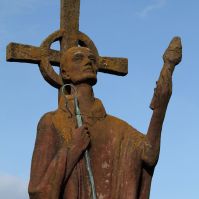
Is Religion on the Way Out Among Young People?
In 1966, Time magazine published one of its most memorable and infamous front covers. In red font against a simple black background were the words, "Is God Dead?" The attention-grabbing cover was doubtlessly designed to move magazines and stir up controversy. It did this admirably, much more so than the article inside the magazine which answered the question was a resounding and - to many readers at the time - reassuring "no."
What Time was getting at was a perceived drop-off in church attendance and religious belief among young people. Though members of older generations tended to be avid church-goers and relatively traditional believers at the time, there was a feeling among many that subsequent generations would forgo belief entirely and American society would move towards secularism. It's led some to ponder what, to some, is unthinkable... God is dead?
Sowing the Seeds of Doubt
In a recent presentation in Australia, physicist and atheism activist Lawrence Krauss told the audience that "Change is always one generation away." He urged the skeptics in the audience to teach younger generations doubt in religion so that religious faith can be largely eradicated in future generations. He equated belief in God to support of racist and homophobic policies, both area in which public opinion shifted quickly over a short period of time.
However, Yale PhD candidate Konika Banerjee disagrees that religious belief was a simple matter of cultural teaching. She has extensively researched the impact patterns that thinking has on belief. In other words, the way the human brain is wired to believe in God. Indeed, several recent findings neurological findings indicate that for many people religious belief may not be as simple as absorbing cultural cues.
- Religious Belief May Be Cognitive: According to Banerjee, there are several habits of the human mind that make people more receptive to religious thought. Namely, people tend to want seemingly random actions and happenings to be intentional; in other words, they want the events that occur every day to fit a narrative pattern. In order to make sense out of seemingly random events, the mind may turn naturally to the idea of God as a guiding force in human lives.
- Humans Look for Patterns and Connections: In addition to naturally looking for narratives and reasons, the human mind naturally strives to find patterns in things. In one of her papers, Banerjee explored what people think about the events that happen in their lives. Those with a strong religious faith were more likely to see things as happening for a reason; however, many non-believers also expressed similar ideas, such as a belief in fate or a universal tendency towards order.
- Religious Belief Starts Early: Interviews conducted with children as young as five and six show that these tendencies are already ingrained in their thinking at this young age. This tendency is present even when the children are not exposed to religion at home.
Though there has been a distinct move towards atheism among young people in America, it seems a little premature to start asking the question, "is God dead?" Religiosity tends to move in cycles. Following the trend towards secularism in the 1960s that spurred the iconic Time article, people once again turned to religion during the 1970s in the form of the Evangelical movement.



